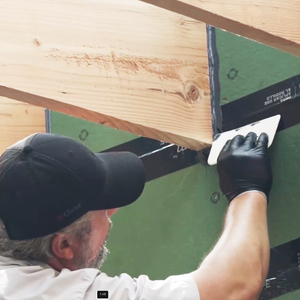*
We are trimming out a new home that has been plastered. Our delima is that at the window and door corners the plaster is usually thicker than the center, or from top to bottom, side to side. Sometimes as much as 1/4″ to nothing. Here’s the kicker, the home owner went to a local saw mill / mill and picked out solid oak doors, base, door and window trim with rosettes. The trim is 3/4″ stock. With the corners being muded up as they are, setting the rosettes and trying to trim out the window is becoming quite the chore. Adding extension jambs, parting stop, what not seems to roll the trim enough to make a guy through his hands in the and say
Discussion Forum
Discussion Forum
Up Next
Video Shorts
Featured Story

There's a constant source of clean water for you to use, and all you have to do is collect it.
Featured Video
Video: Build a Fireplace, Brick by BrickHighlights
"I have learned so much thanks to the searchable articles on the FHB website. I can confidently say that I expect to be a life-long subscriber." - M.K.

















Replies
*
Take a hammer, smash out the offending plaster, set your trim, and have the GC call the plasterer back in. No, really. Old houses have a wood ground strip around windows and doors that helped keep the plaster nice and even. Having to freehand it seems tough for newer guys...help them out with a little lesson on keeping the plaster even around openings.
*First, extend the jambs to make it closer to right at the shallow dim. This will make the jamb proud in other areas. Since there are corner blocks, you might think joining the casings/blocks with biscuits b/4 install and put it up as one pc. Or biscuits and shims to help register it before nailing pc by pc. The backside is gonna float from the plaster at the high pts. How you deal with that is your decision. We've just moved the problem to another location but maybe halved the difference in the plane.
*First, set the trim as if everything were right. This will leave gaps up to a quarter inch between the trim and the jam at the high spots. It's okay because you only used two brads in each piece of trim, so that you can take the trim back off later. Now trace the rosettes and the casing at the high spots with your trim knife. Take the trim off. Cut the plaster carefully along the score lines that you made with your knife, with a grinder set up with a masonry wheel. (If you have a helper to hold a Shop-Vac while you cut the plaster, it will save lots of cleanup effort.) Now knock the plaster out and re-set the trim. Everything should line up right now, and we don't have to call the plasterers back.
*Thanks guys, your suggestion's will be applied. I thought about installing 1/4" extension jambs around doors and windows before the plaster crew gets their hands in the mud and let them build up to our jambs instead of us scratching out their plaster. Any thoughts on this, or would the mud boys still run over.
*Didn't know that was an option. I would try it. You know the extent of the job, and can figure the outcome right? You make the call. When faced with the occasional need to add mud to make a critical plane right, I do it. A plaster ground works well. If the extension is stain grade, you might want to think protection. Best of luck
*I have done what Matthew recommended and while it works well, it takes a lot of time. Especially when you multiply it times all windows and doors and then the cleanup of the mess. If the jambs were in place before the plastering and it was understood that the plasterer was to meet them, then this is his responsiblity to either fix or pay for the correction. Hopefully he has not yet been paid. This could turn an entire trim job into a financial loser.On another note, if you do scrape, get yourself a scraper (Sandvik makes them) with a replaceable carbide blade. They last forever, even when scraping plaster.
*Mathew, I was just looking at some trim I'll be doing soon that has this very same problem. Your idea seems sound, but a couple of questions. I'm assuming you are looking for a very good score of the plaster, to assure a clean break. Without a clean edge, the plaster will need repair to bring it to the edge of the casings. What kind of knife do you use on the plaster? Will this technique work with 1/8" plaster over blue-board? If there is a little ugly here and there, can it be patched with something other than a plasterer and then repainted? Thanks
*Thanks again for the input. I understand the scraping to get back even with window jambs but even with touch up you lose the depth of the trim IMO. I guess in the end curtains cover up half our work anyway.
*Nathan, I just use my Stanly razor knife for a light score. Then when the trim is back off I use a roto zip with the angle attachment and a diamond blade to actually cut the plaster. Diamond blades go through plaster like butter and they last forever when that's all you cut. Remember to use a shop vac while you cut the plaster or it's a big dust storm I always were a dust mask too. As for nicks and chips, the painters I work with use Easy sand for the small stuff and brown coat for the big ones.
*Thanks. I get the impression this is something one could get good at.